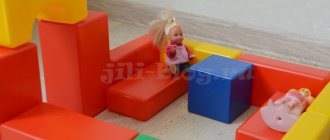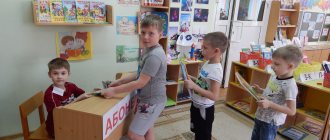Methods of pedagogical guidance of plot-role-playing games for preschool children
Methods of pedagogical guidance of plot-role-playing games for preschool children
Kashina E.V.
Currently, much attention is paid to the problem of socialization in the development and education of preschool children.
The process of socialization begins in childhood and continues throughout life. The child strives for active activity, and it is important not to let this desire fade away; it is important to promote his further development. The more complete and varied a child’s activity is, the more significant it is for the child and the more consistent with his nature, the more successful his development is. That is why games and active communication with others - with adults and peers - are the closest and most natural for a preschooler.
The plot-role-playing game is the first test of social forces and their first test.
The uniqueness of children's play requires great delicacy from an adult in the pedagogical guidance of this activity. He must become a benevolent participant in the game, regardless of whether he takes on any role or not.
What is the content of a teacher’s work in nurturing creative abilities in preschool children in role-playing games?
The teacher’s skill is most clearly demonstrated in organizing children’s independent activities. How to direct each child to a useful and interesting game without suppressing his activity and initiative? How to alternate games and distribute children in a group room or area so that they can play comfortably without disturbing each other? How to eliminate misunderstandings and conflicts that arise between them? Both the comprehensive education of children and the creative development of each child depend on the ability to quickly resolve these issues.
When leading role-playing games, educators are faced with the following tasks:
• development of games as an activity (expanding the themes of games, deepening their content);
• using the game to educate children's groups and individual children,
Directing a role-playing game requires great skill and pedagogical tact. The teacher must direct the game without disturbing it, and maintain the independent and creative nature of the game activity.
Preschool pedagogy describes many methods and techniques of influencing children, the choice of which depends on the specific situation.
There are methods and techniques that help enrich the content of the game: the teacher plays the main role; individual play between the teacher and the child, with the teacher playing the main role; introducing figurative toys; parallel game technique; role-playing game with continuation; activating communication between an adult and children during their play, aimed at awakening and independent application by children of new ways of solving a game problem, at reflecting new aspects of life in the game; telephone game; playing out scenes of life in kindergarten with the help of dolls; playing out imaginary situations with children. And also those that contribute to the regulation of gaming relationships: games that facilitate adaptation (“come visit me”), the participation of the teacher in the game (the main role); use of a multi-character plot (2 doctors, 2 drivers); introducing a puppet character, setting rules of behavior on his behalf; creation of multi-age play triads.
Methodological methods and techniques give results and bear fruit only in those cases if the teacher applies them systematically, takes into account the general trends in the mental development of children, the patterns of formed activity, if he knows and feels each child of his group well
The teacher’s task in working with older children is to expand and deepen their play interests and create conditions that encourage children to be creative. The teacher, with his advice, suggestions, and questions, should guide the children to find an independent way out of difficult situations. Gradually, the teacher moves from being a direct participant in the game to the role of an adviser in it. In addition, the teacher consistently leads children to the use of all previously undeveloped play tools, the production of play aids, the introduction of toys with the obligatory discussion of the issue of how these toys are used. In the future, the teacher, when working with older children, teaches them to transfer the acquired knowledge into play and continues to develop their basic planning and organizational skills.
The teacher must guide the game without destroying it, preserve the amateur and creative nature of children’s play activities, the spontaneity of experiences, and faith in the truth of the game. The teacher influences the play concept and its development, enriching the content of children’s lives: it expands their ideas about the life of adults, about the relationships between people, and thereby concretizes the content of a particular play role.
However, in expanding the knowledge and understanding of preschoolers, it is necessary to observe moderation. An overabundance of impressions can lead to superficial reflection in games of the unimportant and random, to their instability, and lack of organization.
A game is a means through which children demonstrate their independence during the distribution of roles and actions during the game. The child lives in the game. And the task of educators is to become a guide and link in the child-game chain, tactfully supporting the leadership to enrich the children’s gaming experience.
Senior preschool age
Direct Leadership Techniques
- inclusion of the teacher in the game, taking on a role (main or secondary) - not often, as necessary (showing a speech sample, collective discussion of the role behavior of the players after the game).
Indirect Leadership Techniques
– enriching children’s social experience through all types of activities (observations, excursions, reading fiction, watching children’s TV shows, conversations)
— involving children in the production of attributes and design of playing fields.
Creating conditions for the development of creative role-playing games:
— creation of an object-game environment;
— use of a modern storage system (arrangement of game material in containers);
- inclusion of “semi-finished toys” into the environment for making homemade products;
— replenishment and enrichment of the gaming environment in accordance with the knowledge acquired in the classroom.
Adult help
- remember events that are more suitable for the game, establish their sequence;
— plan the course of the game, the sequence of actions;
— distribute roles, agree on plans;
— assistance in solving game problems, maintaining cognitive interest in the game;
- watching children play;
- direction of children’s plans and actions (advice, hint, question, change in the play environment);
— creation of problematic situations (flexible influence on the game concept, plot development, complication of ways of displaying reality;
- create a game situation;
- individual work (if the child does not know how to play, you can use the experience of children who play well).
Methods and means of guiding children's play activities
The process of leading a role-playing game should be structured so that the development of gaming skills is organically combined with training and education. Based on this principle, scientists distinguish 3 groups of methods (T.A. Markova, V.G. Nechaeva, S.L. Novoselova, etc.).
The first group of methods is associated with enriching children with knowledge, impressions, and ideas about the life around them. These include observations; excursions (initial, repeated, final); meetings with people of different professions; emotionally expressive reading of fiction; conversation; conversation-story using illustrative material about the work of adults and their relationships in the process; the teacher’s story, accompanied by a demonstration of specially selected photographs, paintings, reproductions about events taking place in the country; children compiling stories on certain topics related to observations of life around them; individual conversations with children, clarifying the knowledge and ideas of preschoolers about the phenomena of social life, about moral categories; staging literary works using toys and puppet theater characters; ethical conversations.
The second group is methods that promote the formation and development of gaming activities. Among them, an important place is occupied by the direct participation of the teacher in creative play: playing with one child, playing a leading or secondary role. In addition, the teacher makes extensive use of helping children implement the knowledge acquired in the classroom through suggestions, reminders, advice, selection of game material, conversation about the concept of the game, development of its content, and summing up.
The teacher takes into account the individual characteristics of the child; if he is confident in himself, it is important to teach him to critically evaluate his answers. If you are shy and indecisive, you need to support any initiative.
In order to develop children's skills and abilities to independently organize play, assignments are also used; tasks (on selecting gaming materials, making homemade toys, etc.); conversations; encouragement, explanations, questions aimed at suggesting to children the possible implementation of the plan, defining game actions.
Skills necessary for a child, such as determining a role for oneself and bringing it to the end of the game, are formed through advice, individual tasks, and assignments; attracting illustrative material, reading excerpts from literary works characterizing a particular character; individual conversations about the role; making costume elements for his role together with the child.
An important task is to develop in children the ability to independently assign roles, taking into account the capabilities, interests and desires of everyone. Therefore, the teacher must study well the characters, inclinations and habits of his pupils and constantly help children get to know each other better, drawing their attention to the positive aspects of each child’s personality. To solve this problem, you can use a technique such as holding competitions for the best design of costume elements, for interesting proposals regarding role-playing actions, for the expressiveness of speech, facial expressions, and gestures.
The third group of methods is associated with teaching children to construct from building materials and play with buildings, and make toys.
An important role is played by teaching children the ability to make toys from paper by folding (boats, steamships, animals, cameras, benches, glasses, etc.), from thin cardboard according to patterns; making toys from natural and additional materials (reels, cardboard boxes of various shapes and sizes, etc.
An important role for the development of the game is the ability of children to use substitute objects (a brick instead of soap, etc.); the more substitute objects children bring, the more interesting and meaningful the game.
Play is a special activity that blossoms in childhood and accompanies a person throughout his life. It is not surprising that the problem of play has attracted and is attracting the attention of researchers, not only teachers and psychologists, but also philosophers, sociologists, ethnographers, and biologists.
It is now generally accepted that play is the leading activity of a preschool child. For young children, the leading activity is object-based activity; for children of younger and older preschool age, the leading activity is play.
Techniques for managing the game can be direct and indirect.
Direct guidance involves direct adult intervention in children's play. It can be expressed in role-playing participation in the game, in participation in the collusion of children, in clarification, in providing assistance, advice during the game, or in proposing a new topic for the game.
Indirect guidance of play is especially fruitful when working with preschool children. The teacher expresses his judgments while playing with children exclusively in the form of advice, without demanding strict obedience.
An adult should give children examples of communication with various people, standards of emotional experiences, carefully monitor the children’s reactions, try to direct their communications, and promote adequate and emotional communication during the game. During learning to play, an adult performs the functions of an organizer and leader of gaming activities.
It is impossible to teach a game other than by playing with a child.
• The game should be free from themes and regulation of actions imposed by adults “from above.” The child must have the opportunity to master the increasingly complex “language” of play - the general ways of its implementation, increasing the freedom to creatively realize his own ideas.
Play should be a joint activity of the teacher and children, where the teacher is a playing partner, so that play at all age stages is an independent activity of children.
To develop gaming activities, it is necessary to fulfill several conditions: the creation of a subject-development environment, the availability of a certain time in the daily routine and the professionalism of teachers. Without these conditions being met, it is impossible to develop children's creative, amateur play.
Didactic play is one of the important methods of active learning for children, and the game situation, as a rule, is taken based on the methodological basis of the lesson. The role of each participant in the game is clearly defined, there are rules and a certain rating system, and the game provides for a strict and step-by-step procedure.
Games not only influence the physical and mental development of preschool children, they are also one of the important means of education.
In order for the game to perform an organizing function in the pedagogical process, the teacher needs to have a good idea of what tasks can be solved in it.
Based on the characteristics of the type of game, the tasks that can be solved with its help, the level of development of play activity in children, the teacher determines the extent of his participation in it, management techniques in each specific case.
However, when directing the game towards solving educational problems, one should always remember that it is a kind of independent activity of a preschooler. In play, a child has the opportunity to demonstrate independence to a greater extent than in any other activity: he chooses the plots of the game, toys and objects, partners, etc.



